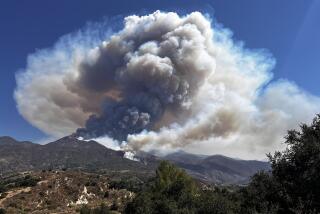Forest Fee Beats the Alternatives
- Share via
It is always a privilege to write about a new and exciting government fee. The culprit this time is the U.S. Forest Service and the target is many of those who use the Angeles National Forest.
Whereas it used to cost nothing to go for a hike in the Angeles, it will soon cost $5 per vehicle for a daily parking pass or $30 for an annual “adventure pass,” good at any of the four national forests in Southern California. This is part of a test program running through 1998 and taking place in 47 of 155 national forests.
The fee can be viewed in two ways. One is that it is pathetic. The Forest Service is now hitting up taxpayers for more money while losing millions of dollars each year on timber sales. Ranchers and miners get similar sweetheart deals in our forests, thanks to laws still rooted in the ideology of the late 19th century.
The other way to view the new fees is with some optimism. Maybe the Forest Service, after years of clear-cutting, bulldozing and servicing our forests in less than beneficial ways, is reforming itself. Maybe, just maybe, paying fees for parking will help our forests become healthier than ever.
*
I am reluctant to portray today’s U.S. Forest Service as the bad guys. Their firefighters are courageous, their scientists top-notch. While camping and hiking, I have consistently found Forest Service rangers to be professional, knowledgeable, courteous and dedicated--in short, model government employees. And they aren’t doing it for the money.
The Angeles is not an easy forest to manage. It is the most visited national forest in the system (with about 33 million visits in 1996) and, unfortunately, a few of those visitors like to crash motorcycles in spectacular fashion, shoot up campgrounds with illegal firearms, set forest fires, spray-paint rocks and, in general, cause an unholy ruckus.
The Angeles needs the money from the new test fees, especially in the wake of federal budget cuts. The good news is that at least 80% of the money collected must go toward recreational improvements, such as trail and road maintenance and campground upgrades, at the national forest where it is collected. Up to 20% of the remaining funds can be used in other national forests, but must go for similar purposes.
In other words, people like you and me are being asked to pay for some of the wear and tear we have wreaked upon the Angeles. Fair enough.
However, here’s a number to think about: In 1996, the Forest Service lost more than $200 million on its logging program, according to the White House’s Council of Economic Advisors. The Sierra Club, which would like to eliminate all commercial logging in national forests (and it should be noted that there is no logging in the Angeles), puts the figure at about $700 million. The organization points out in a report that $1.3 billion was spent on the logging program, which “generated only $535 million in timber sales receipts--none of which was returned to taxpayers.” And, as bad as that sounds, 1996 was actually a fairly good year for the logging program.
The problem is this: Because of a 1906 mandate to provide a sustainable and continuous supply of lumber for the U.S., the Forest Service absorbs virtually all of the administrative costs of logging, as well as the cost of reforestation. At the same time, lumber from our forests is sold at “fair market value,” which often doesn’t even cover the Forest Service’s costs. This is corporate welfare at its finest, and the timber industry has done a fine job over the years of finding politicians to protect its interests.
Further, it’s a fact that heavy logging in the last 50 years has caused severe environmental damage to national forests. Habitat for critical species has been lost, as has more than 80% of our old-growth forests. At one point, in what can only be described as arrogance, parts of the Targhee National Forest in Idaho were clear-cut virtually to the boundary of Yellowstone National Park, as if the ecosystem knew where to stop.
*
In a speech in April, Forest Service chief Mike Dombeck told his regional foresters and directors that our national forests received about 860 million visits in 1996, resulting in $112 billion generated to state economies and local communities. Dombeck also said “a healthy environment is a major stimulus for a healthy economy” and that the health of our forests should be the “driving force” behind all decisions made by the Forest Service.
I couldn’t agree more. If the recreational test fees were to become permanent in all national forests, huge amounts of revenue could be raised--certainly more than could ever be made by resource extraction. Just being beautiful, it turns out, is the best way for our national forests to turn a profit.
On the eve of a new millennium, it’s a wonderful notion. And a bargain at just $5.
More to Read
Sign up for The Wild
We’ll help you find the best places to hike, bike and run, as well as the perfect silent spots for meditation and yoga.
You may occasionally receive promotional content from the Los Angeles Times.






